Python Functions
About 7 min
Python Functions
- Sequence/Selection/Iteration Statements
- Functions
- Built-in Functions
- Higher-order Functions
- Built-in Higher-order Functions
1. Sequence/Selection/Iteration Statements
1.1. Conditionals 选择
# if
a = 3
if a > 0:
print('A is a positive number')
# else
a = 3
if a < 0:
print('A is a negative number')
else:
print('A is a positive number')
# elif
a = 0
if a > 0:
print('A is a positive number')
elif a < 0:
print('A is a negative number')
else:
print('A is zero')
# code if condition else code
a = 3
print('A is positive') if a > 0 else print('A is negative') # first condition met, 'A is positive' will be printed
1.2. Loops 循环
# while
count = 0
while count < 5:
print(count)
count = count + 1
# for string/list/tuple/set
for item in string/list/tuple/set:
print(item)
# for string/list/tuple
for i in range(len(string/list/tuple)):
print(String[i]/list[i]/tuple[i])
# for dict
for key in dict:
print(key)
for key,value in dict.items():
print(key,value)
1.2.1. else 循环结束后执行
# while else (while结束后会走到else)
count = 0
while count < 5:
print(count)
count = count + 1
else:
print(count)
# for else (for结束后会走到else)
for number in range(11):
print(number) # prints 0 to 10, not including 11
else:
print('The loop stops at', number)
1.2.2. Break&Continue 关键字
# break
count = 0
while count < 5:
print(count)
count = count + 1
if count == 3:
break
# continue
numbers = (0,1,2,3,4,5)
for number in numbers:
print(number)
if number == 3:
continue
print('Next number should be ', number + 1) if number != 5 else print("loop's end") # for short hand conditions need both if and else statements
print('outside the loop')
1.2.3. Pass 关键字(占位)
for number in range(6):
pass
2. Functions
2.1. 声明函数 Declare Function
Note:python用缩进创造一个代码块,其他语言用括弧brackets创造一个代码块
- def 关键字——声明函数
- return 关键字——返回函数值;可以返回任意类型,甚至是函数;函数里没有返回值,则默认返回None。
- 参数:可以没有参数,也可以有多个参数,也可以通过**args,args不限定参数个数;参数可以指定默认值;参数可以是任意类型,甚至是函数。
# 声明模板
def function_name(argList):
function_body
[return return_value]
# 不限定参数个数: *args,针对list和tuple的unpack
def generate_groups (team,*args):
print(team)
for i in args:
print(i)
print(generate_groups('Team-1','Asabeneh','Brook','David','Eyob'))
# 不限定参数个数:**args,针对dict的unpack
def packing_person_info(**kwargs):
# check the type of kwargs and it is a dict type
# print(type(kwargs))
# Printing dictionary items
for key in kwargs:
print("{key} = {kwargs[key]}")
return kwargs
print(packing_person_info(name="Asabeneh",
country="Finland", city="Helsinki", age=250))
2.2. 调用函数 Call/Invoking Function
- 调用时,参数指定key和value,可以不按参数列表顺序传参
def add_two_numbers (num1, num2):
total = num1 + num2
print(total)
print(add_two_numbers(num2 = 3, num1 = 2))
- 参数指定了默认值的,可以不传
# 参数指定默认值
def calculate_age (birth_year,current_year = 2021):
age = current_year - birth_year
return age;
print('Age: ', calculate_age(1821)) # 可以不传第2个参数
print('Age: ', calculate_age(1821,2023))
2.3. 匿名函数 Lambda Function
1、赋值给变量
# syntax
x = lambda param1, param2, param3: param1 + param2 + param2
print(x(arg1, arg2, arg3))
# example
add_two_nums = lambda a, b: a + b
print(add_two_nums(2,3)) # 5
2、自调用(一次性函数)
# Self invoking lambda function
(lambda a, b: a + b)(2,3) # 5 - need to encapsulate it in print() to see the result in the console
3、在另一个函数内
def power(x):
return lambda n : x ** n
cube = power(2)(3) # function power now need 2 arguments to run, in separate rounded brackets
print(cube) # 8
two_power_of_five = power(2)(5)
print(two_power_of_five) # 32
2.4. 类型提示(→)
# 函数会返回一个布尔类型
def _get_verbosity() -> bool:
from langchain.globals import get_verbose
return get_verbose()
3. Built-in Functions
3.1. 所有内置函数
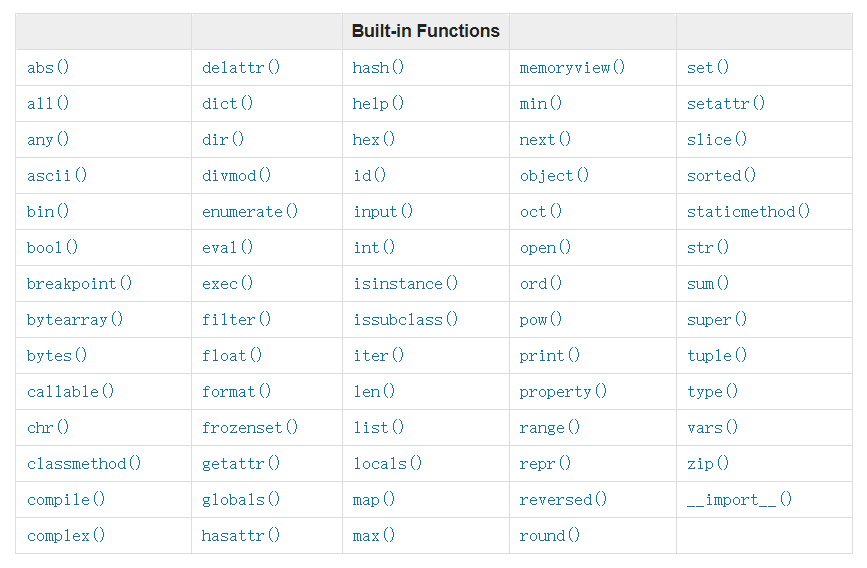
3.2. 常用内置函数
print(), input(), len(), type(), help()
int(), float(), str(), list(), dict(),
min(), max(), sum(), sorted(),
open(), file(), and dir()
3.2.1. help()&dir() 查看所有功能(模块,关键字,数据类型)
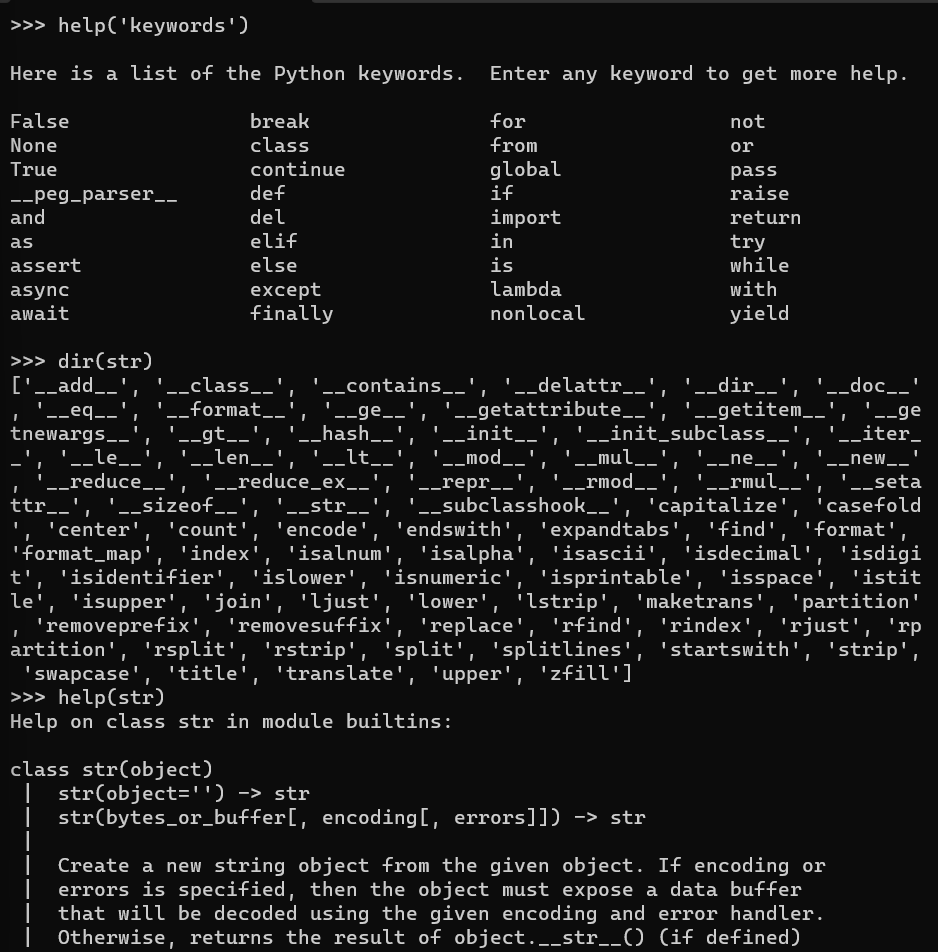
# 查看模块所有功能
import math
print(help(math))
print(dir(math))
3.2.2. print() 输出
print()函数可传无限个参数,多个参数用逗号“,”隔开,结果是连成一串输出,遇到逗号“,”会输出一个空格
交互模式下不用print()也可输出,命令模式下需要print()才可输出
>>> print('Hello,World!')
Hello,World!
>>> print('Hello',',','World','!')
Hello , World !
>>> print(len('Hello,World!'))
12
>>> print('100 + 200 =', 100 + 200)
100 + 200 = 300
>>> print('The quick brown fox', 'jumps over', 'the lazy dog')
The quick brown fox jumps over the lazy dog
>>> print(100 + 200)
300
3.2.3. input() 输入
通过input()动态给变量赋值
可以不传参,也可以传参给用户提供输入信息
# 不传参
>>> name = input()
>>> name
Michael
# 传参
>>> name = input('please enter your name: ')
>>> print('hello,', name)
hello, Michael
3.2.4. open() 文件处理(配合os模块)
3.2.5. 打开文件——手动关闭方式
f = open(filename,mode) # mode:r a w x t b
f = opne(filename) # mode可以不传,默认是 rt
- "r" - Read - Default value. Opens a file for reading, it returns an error if the file does not exist
- "a" - Append - Opens a file for appending, will append to the end of the file, creates the file if it does not exist
- "w" - Write - Opens a file for writing, will overwrite any existing content,creates the file if it does not exist
- "x" - Create - Creates the specified file, returns an error if the file exists
- "t" - Text - Default value. Text mode
- "b" - Binary - Binary mode (e.g. images)
需要手动关闭
f.close() # 手动关闭
3.2.6. 打开文件——自动关闭方式
with语句适用于对资源进行访问的场合,能自动处理上下文环境产生的异常。确保不管使用过程中是否发生异常,都会执行必要的“清理”操作,释放资源。
with open('./files/reading_file_example.txt') as f:
lines = f.read().splitlines()
print(type(lines))
print(lines)
3.2.7. 读文件
txt = f.read() # 读所有,返回str
txt = f.read(10) # 读前10个字符,返回str
lines = f.read().splitlines() # # 读所有行,返回list
line = f.readline() # 读一行,返回str
lines = f.readlines() # 读所有行,返回list
3.2.8. type() 验证数据类型
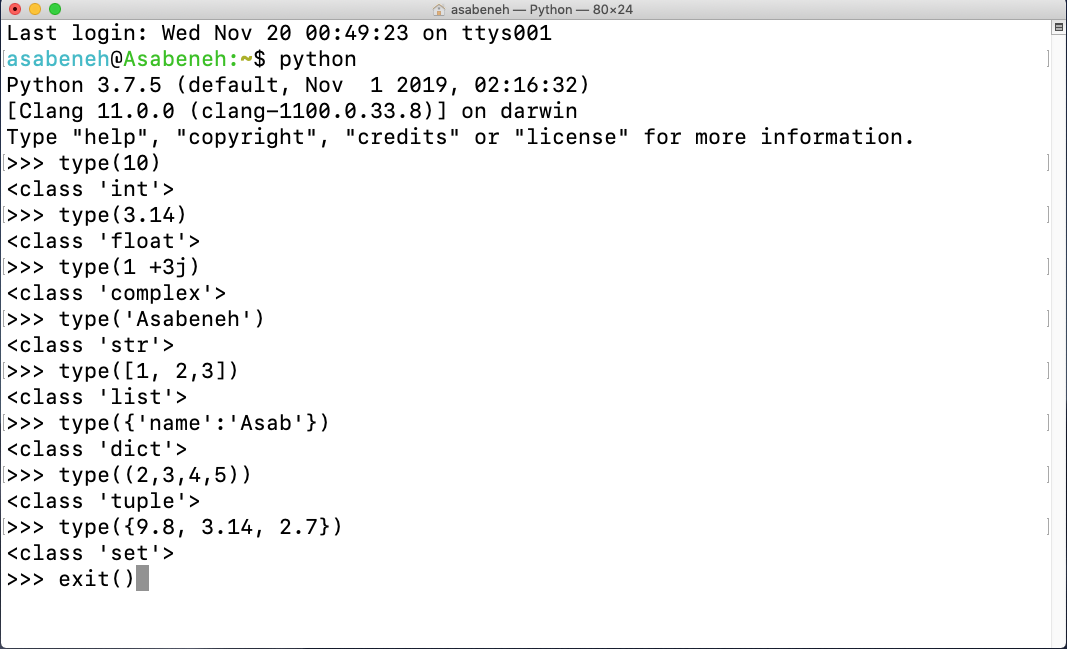
3.2.9. int(),float(),str(),list(),set() 转换数据类型
# int to float
num_int = 10
print('num_int',num_int) # 10
num_float = float(num_int)
print('num_float:', num_float) # 10.0
# float to int
gravity = 9.81
print(int(gravity)) # 9
# int or float to str
num_int = 10
print(num_int) # 10
num_str = str(num_int)
print(num_str) # '10'
# str to int or float
num_str = '10.6'
print('num_int', int(num_str)) # 10
print('num_float', float(num_str)) # 10.6
# str to list
first_name = 'Asabeneh'
print(first_name) # 'Asabeneh'
first_name_to_list = list(first_name)
print(first_name_to_list) # ['A', 's', 'a', 'b', 'e', 'n', 'e', 'h']
3.2.10. len() 长度
获取string,list,tuple,set,dict的长度
3.2.11. range() 整数列表
range(start,end,step)
默认:start=0,step=1
至少需要1个参数,即end
lst = list(range(11))
print(lst) # [0, 1, 2, 3, 4, 5, 6, 7, 8, 9, 10]
st = set(range(1, 11)) # 2 arguments indicate start and end of the sequence, step set to default 1
print(st) # {1, 2, 3, 4, 5, 6, 7, 8, 9, 10}
lst = list(range(0,11,2))
print(lst) # [0, 2, 4, 6, 8, 10]
st = set(range(0,11,2))
print(st) # {0, 2, 4, 6, 8, 10}
for number in range(11):
print(number) # prints 0 to 10, not including 11
3.2.12. min(),max(),sum()
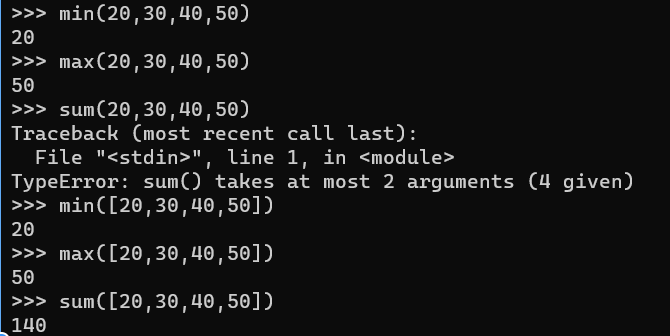
4. Higher-order Functions
4.1. 函数作为参数
# 函数作为参数
def square_number (n):
return n * n
def do_something(f, x):
return f(x)
print(do_something(square_number, 3)) # 9
4.2. 函数作为返回值
根据不同参数返回不同函数
def square(x): # a square function
return x ** 2
def cube(x): # a cube function
return x ** 3
def absolute(x): # an absolute value function
if x >= 0:
return x
else:
return -(x)
def higher_order_function(type): # a higher order function returning a function
if type == 'square':
return square
elif type == 'cube':
return cube
elif type == 'absolute':
return absolute
result = higher_order_function('square')
print(result(3)) # 9
result = higher_order_function('cube')
print(result(3)) # 27
result = higher_order_function('absolute')
print(result(-3)) # 3
4.3. 闭包 Python Closures
Python 允许嵌套函数访问封闭函数的外部范围。这就是闭包。
def add_ten():
ten = 10
def add(num):
return num + ten
return add
closure_result = add_ten()
print(closure_result(5)) # 15
print(closure_result(10)) # 20
4.4. 装饰器 Python Decorators
不修改object结构的情况下,给object添加新功能
4.4.1. 应用单个装饰器到一个函数
# 定义装饰器
def uppercase_decorator(function):
def wrapper():
func = function()
make_uppercase = func.upper()
return make_uppercase
return wrapper
# 应用装饰器
@uppercase_decorator
def greeting():
return 'Welcome to Python'
# 结果展示
print(greeting()) # WELCOME TO PYTHON
4.4.2. 应用多个装饰器到一个函数
Note:装饰器的顺序很重要,靠函数近的装饰器先执行(也就是一个函数上的装饰器,执行顺序是从下到上)
如果变更两个装饰器的顺序会报错,如下图所示:
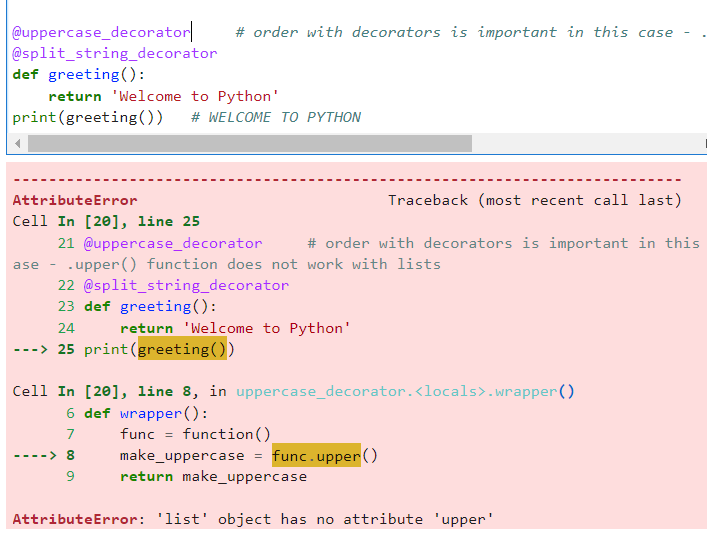
'''These decorator functions are higher order functions
that take functions as parameters'''
# First Decorator
def uppercase_decorator(function):
def wrapper():
func = function()
make_uppercase = func.upper()
return make_uppercase
return wrapper
# Second decorator
def split_string_decorator(function):
def wrapper():
func = function()
splitted_string = func.split()
return splitted_string
return wrapper
@split_string_decorator # 后执行
@uppercase_decorator # 先执行
def greeting():
return 'Welcome to Python'
print(greeting()) # WELCOME TO PYTHON
4.4.3. 接收参数的装饰器
def decorator_with_parameters(function):
def wrapper_accepting_parameters(para1, para2, para3): # 此处接收参数,和被装饰函数的参数保持一致
function(para1, para2, para3)
print("I live in {}".format(para3))
return wrapper_accepting_parameters
@decorator_with_parameters
def print_full_name(first_name, last_name, country):
print("I am {} {}. I love to teach.".format(
first_name, last_name, country))
print_full_name("Asabeneh", "Yetayeh",'Finland')
5. Built-in Higher-order Functions
5.1. map(function,iterable) :把function应用于序列中每一项
返回结果是一个map object,需要用list等函数转成想要的类型
numbers = [1, 2, 3, 4, 5] # iterable
def square(x):
return x ** 2
numbers_squared = map(square, numbers)
print(list(numbers_squared)) # [1, 4, 9, 16, 25]
# Lets apply it with a lambda function
numbers_squared = map(lambda x : x ** 2, numbers)
print(list(numbers_squared)) # [1, 4, 9, 16, 25]
names = ['Asabeneh', 'Lidiya', 'Ermias', 'Abraham'] # iterable
names_upper_cased = map(lambda name: name.upper(), names)
print(list(names_upper_cased)) # ['ASABENEH', 'LIDIYA', 'ERMIAS', 'ABRAHAM']
5.2. reduce(function, iterable):返回单个值
numbers_str = ['1', '2', '3', '4', '5'] # iterable
def add_two_nums(x, y):
return int(x) + int(y)
total = reduce(add_two_nums, numbers_str)
print(total) # 15
5.3. filter(function, iterable):留下function返回True的序列中的项
# Lets filter only even nubers
numbers = [1, 2, 3, 4, 5] # iterable
def is_even(num):
if num % 2 == 0:
return True
return False
even_numbers = filter(is_even, numbers)
print(list(even_numbers)) # [2, 4]
